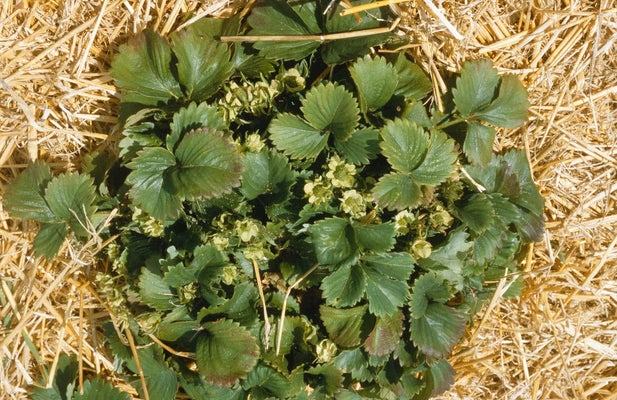
Quick facts
Common name - Various
Scientific name - ‘Candidatus Phytoplasma’, followed by the specific name, e.g. ‘Candidatus Phytoplasma fragariae’
Plants affected - Strawberry, raspberry, blackberry and hybrid berries
Main symptoms - Yellow leaves, green flowers, abnormal fruit production, shoot proliferation, stunting
Caused by - Phytoplasmas
Timing - Various
What are berry fruit phytoplasmas?
Phytoplasmas are the plant-infecting members of a class of bacteria called Mollicutes. They are found within the (which carry the products of around the plant) and are transmitted by feeding insects, such as leafhoppers, planthoppers and psyllids. Phytoplasmas cannot be grown in artificial culture away from their host plant. DNA-based diagnostic techniques are important in determining the species of phytoplasma infecting a plant.General information on phytoplasmas and their naming can be found on the Phytoplasmas advice profile .
Globally, there are a number of phytoplasmas known to infect strawberries, raspberries, blackberries and berries.
Strawberry
Records of strawberry phytoplasma disease are limited in the UK. The strawberry-infecting phytoplasmas 'Candidatus Phytoplasma fragariae' (Strawberry yellows) and 'Candidatus Phytoplasma solani’ have been reported in the UK, though the former only in hazel (in 2014), and while the latter has caused an outbreak in UK strawberries in 2014, this was eradicated by 2017.
Raspberry, blackberry and hybrids
In the UK, two phytoplasmas have been associated with Rubus stunt disease, ‘Candidatus Phytoplasma ulmi’ and ‘Candidatus Phytoplasma pruni’. The latter phytoplasma has also been found to cause Black raspberry witches-broom disease in the USA.
Symptoms
Plants infected with a phytoplasma can show a wide variety of symptoms depending on the phytoplasma species involved. Symptoms can include:
- Flower symptoms: phyllody (formation of leaf-like tissues instead of flowers), virescence (greening of floral parts)
- Stunting, yellowing and abnormal fruit production
- Witches’ broom (development of numerous tiny shoot branches with small leaves)
- Proliferation (growth of shoots from floral organs)
Phytoplasma infection is often fatal for the plant.
Phytoplasma symptoms recorded in strawberries include stunting, phyllody, virescence, and fruit with the appearance of a green flower, red leaves and the formation of leaves in the fruit.
Rubus stunt disease symptoms in raspberries include stunted growth, flower proliferation, enlarged sepals, small leaves, short internodes and fruit malformation.
Control
Non-chemical control
As phytoplasma diseases are often fatal and result in inedible fruit, plants developing a combination of the above symptoms are probably best destroyed as they could act as a source of the pathogen for other plants.
Chemical control
There are no chemicals available for the control of diseases caused by phytoplasmas. Chemical control of the insect vectors by gardeners is not practical due to the sporadic nature of transmission.
Resistance: Cultivars vary in the degree of resistance they show to each phytoplasma, but none are widely resistant to the extent they can be recommended on this basis.
Biology
Phytoplasmas are the plant-infecting members of a class of bacteria called Mollicutes. There are references going back to the early 17th century to symptoms of diseases that are now known to be caused by phytoplasmas.
Phytoplasmas lack a cell wall and are confined to the (which transport the products of ) within the plant. They rely on insect vectors (leafhoppers, plant hoppers and psyllids) to move them from one host plant to another. The vectors feed on plants by probing into the phloem vessels. In doing so, they become contaminated with the phytoplasma, which eventually finds its way into the salivary glands so that it can be transmitted to other plants.
Phytoplasmas can overwinter either within the insect vector or within host plants. They cannot survive outside of their host plant or vector, and cannot be grown in artificial culture. DNA-based diagnostic techniques are therefore important in detecting and determining the species of phytoplasma infecting a plant.
Some phytoplasmas have very wide host ranges and can produce a huge array of symptoms. For example, ‘Candidatus Phytoplasma asteris’ (a member of the aster yellows group) has been recorded on more than 200 plant species, and causes diseases with over 100 different names based on the plant affected and the symptoms produced (e.g. delphinium virescence, mulberry dwarf).
Some of the most damaging phytoplasma diseases are found in tropical or subtropical climates, for example lethal yellowing of palms. However, phytoplasmas can also cause significant economic damage in temperate climates. Aster yellows causes yield and quality problems in a wide range of vegetable and ornamental crops in temperate areas. In New Zealand ‘Candidatus Phytoplasma australiense’ causes Phormium yellow leaf, strawberry lethal yellows, Cordyline sudden decline and Coprosma lethal decline.




